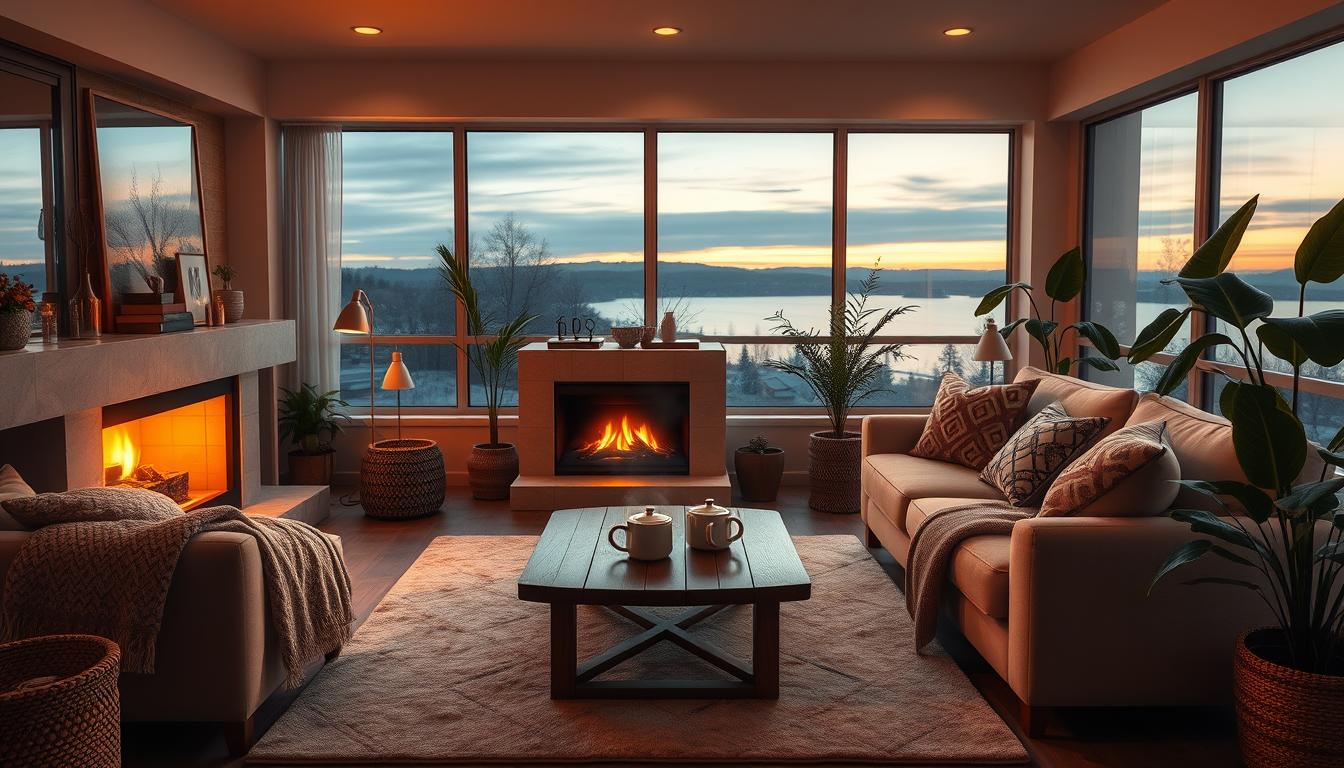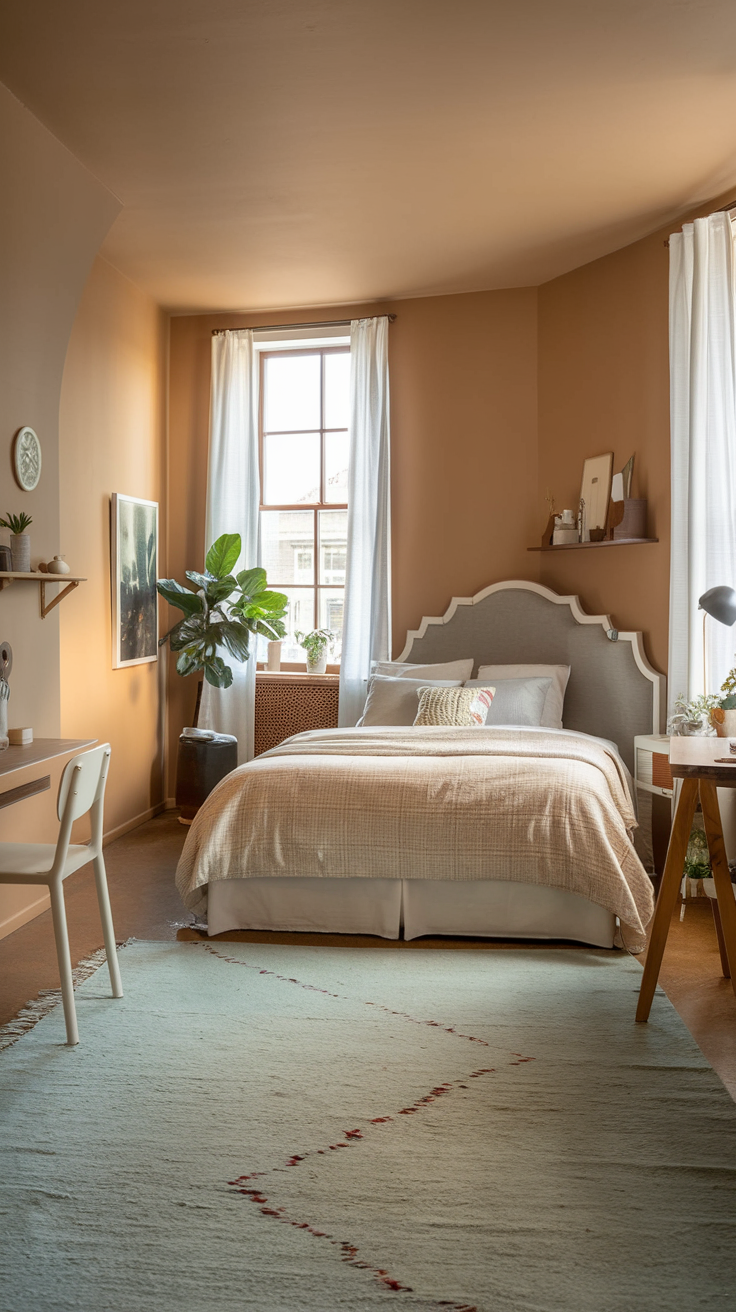Cozy living is an art that transforms any space into a warm, inviting sanctuary. Whether you’re in a small apartment or spacious home, mastering cozy living can help you create a comfortable retreat that nurtures both body and soul. This comprehensive guide explores the essential elements of cozy living and shares 100 practical ideas to help you design your perfect haven.
Cozy living is all about creating a sanctuary. It’s a place where you can relax, recharge, and feel at peace. We’ll explore what makes a space cozy and how to make it your own.
So, grab your favorite hot drink and get comfy. Let’s explore cozy living together. By the end, you’ll have lots of ideas to make your home a cozy haven.
Key Takeaways:
- Understand the essence of coziness and what makes a space truly inviting
- Discover the five core principles of cozy design
- Learn how to create cozy spaces room by room, from living room sanctuaries to bedroom retreats
- Explore the role of lighting, textiles, and natural elements in creating a warm ambiance
- Gain insights into personalizing your cozy space and making it uniquely yours
Understanding the Essence of Coziness
What does a cozy space mean to you? Maybe it’s the warm glow of a fireplace or the soft feel of a knit blanket. Or perhaps it’s the smell of freshly baked cookies. Coziness is about more than just looks; it’s about feeling safe, relaxed, and content.
What Makes a Space Truly Cozy?
A cozy space feels like home. It has a warm, inviting feel. You’ll find snug furniture and calming colors. The right mix of these elements makes a space truly cozy.
And remember, you don’t need a large space to create a cozy haven. In fact, smaller spaces often naturally lend themselves to coziness. For innovative ideas on maximizing coziness in compact living areas, check out our guide on Small Space Cozy Living: Big Style in Tiny Places. This resource shows how limited square footage can become an advantage in creating an intimate, welcoming atmosphere.
The Science of Comfort and Well-being
Our love for coziness is natural. Research shows that certain things make us feel better. Natural light, nice smells, and comfy temperatures can lower stress and boost our mood. By adding these to our homes, we create a space that supports our well-being.
Cultural Perspectives on Coziness
Moreover coziness is celebrated worldwide, each culture in its own way. The Danish love hygge, which is all about warmth and enjoying life’s little things. The Swedes focus on lagom, finding balance in their homes. Learning from these cultures helps us make our homes cozier.
“Coziness is about warmth, comfort, and a sense of belonging. It’s the feeling of being surrounded by the things and people you love, in a space that feels like home.”
| Cultural Concept | Key Elements |
|---|---|
| Hygge (Danish) | Warmth, comfort, simplicity, togetherness |
| Lagom (Swedish) | Balance, moderation, functionality, sustainability |
| Wabi-sabi (Japanese) | Imperfection, simplicity, natural beauty, authenticity |
The Five Core Principles of Cozy Living Design
To make a space cozy, five key principles are essential. Furthermore these are balance and proportion, layering and texture, personal connection, functional comfort, and sensory harmony. By using these, any room can become a cozy haven.
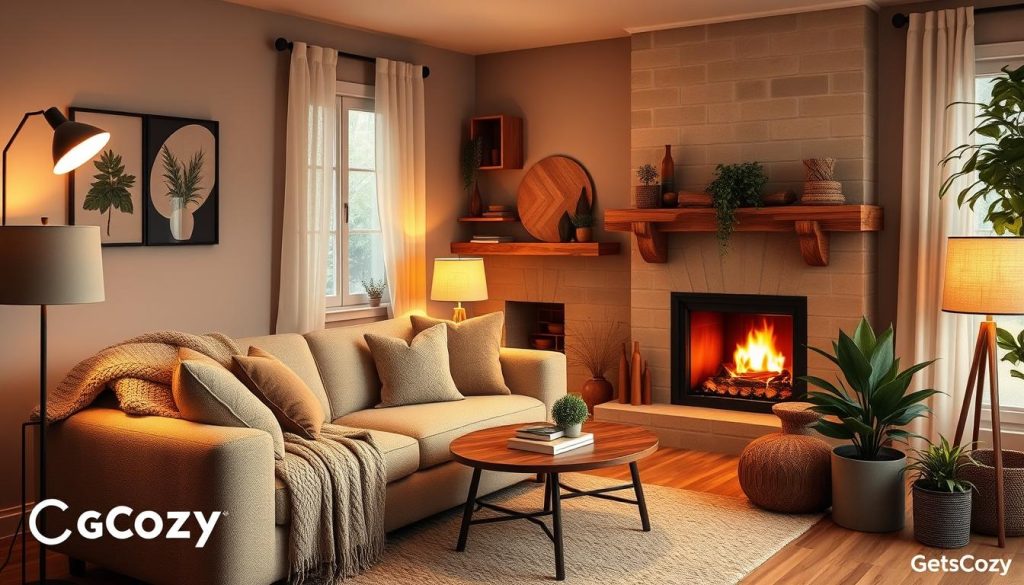
Balance and Proportion
Balance and proportion are key in cozy design. It’s about arranging furniture, lighting, and decor in a balanced way. This creates a calm and comfortable atmosphere.
Layering and Texture
Layering and texture add depth and interest. Using soft fabrics, plush rugs, and textured pillows creates a cozy feel. These elements make the space visually appealing and comfortable to touch.
Personal Connection
A cozy space should show your personality. Adding personal touches like photos, artwork, or special objects makes it feel more intimate. These elements help you feel at home and happy.
Functional Comfort
Cozy design is about more than looks. It’s about making a space comfortable and functional. Choose furniture that’s both good-looking and supportive. Think about ergonomics, size, and how it’s arranged to make the space relaxing.
| Principle | Key Elements | Benefits |
|---|---|---|
| Balance and Proportion | Scale, placement, visual harmony | Promotes relaxation and comfort |
| Layering and Texture | Soft fabrics, plush rugs, textured pillows | Adds depth, interest, and tactile appeal |
| Personal Connection | Photographs, artwork, sentimental objects | Creates emotional connection and intimacy |
| Functional Comfort | Ergonomic furniture, supportive seating | Encourages relaxation and ease of use |
By following these five principles, you can make a space that’s not just pretty but also feels welcoming. Whether you’re reading a book or with friends, a cozy space is perfect for comfort and joy.
Essential Elements of a Cozy Living Space
Making a space cozy is more than just adding throw pillows and blankets. It’s about designing with care, focusing on elements that bring warmth and comfort. Let’s look at the key parts that make a room feel welcoming.
Lighting is key in setting a space’s mood. Use task lighting for places like reading nooks and accent lighting to show off decor. Soft, warm lights, like table lamps, make a space cozy.
Textile selection and layering add depth and interest. Pick fabrics that feel good, like velvet or cotton. Layering throws, pillows, and rugs in matching colors and patterns makes a space rich and inviting. Mixing textures adds to the coziness.
Color is the place where our brain and the universe meet. – Paul Klee
Understanding color psychology and palettes is crucial for coziness. Warm colors like reds and oranges create comfort. Use these with neutral colors like whites or grays to let the warm colors stand out.
In addition, Furniture placement and flow are also important. Arrange seating to encourage talking and togetherness. Make sure there’s room to move but keep it cozy and inviting.
| Element | Cozy Design Tip |
|---|---|
| Lighting | Mix task and accent lighting for a layered, warm ambiance |
| Textiles | Layer plush, touchable fabrics in complementary colors and textures |
| Color Palette | Incorporate warm, earthy tones paired with neutral bases |
| Furniture Layout | Arrange seating to facilitate conversation and togetherness |
By focusing on these key elements, you can make a cozy space. It will be a place where you feel welcome and at home.
Lighting Cozy Living Fundamentals
Lighting is key to making any space cozy and inviting. Understanding how to use different lights can turn your living areas into warm havens. Let’s look at the main lighting aspects that make a space feel cozy.
Natural Light
Use natural light whenever you can. It brightens a room and connects it to the outdoors. Use sheer curtains or adjustable blinds to control light. Place furniture to catch natural light, making cozy spots for reading or relaxing.
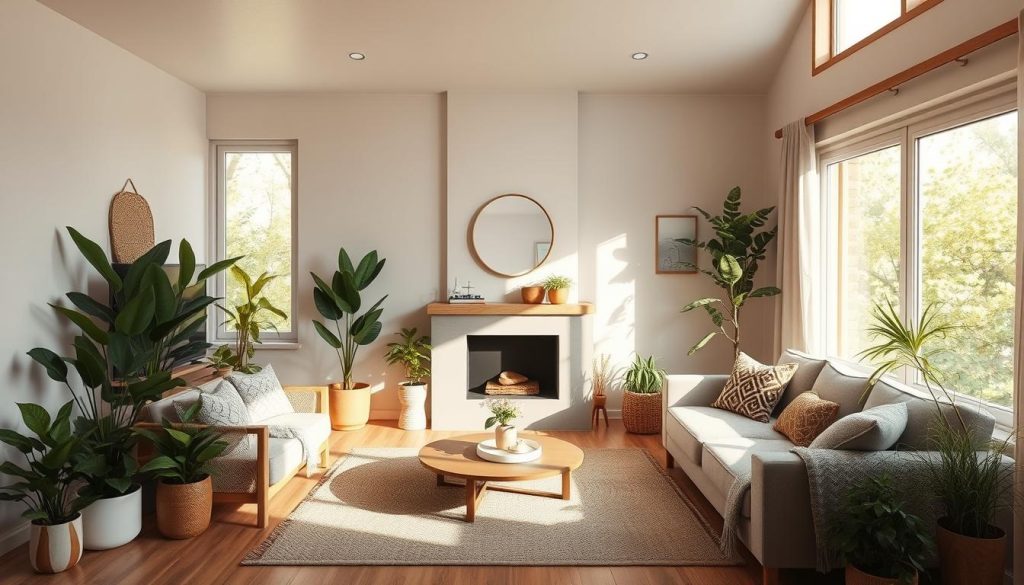
Ambient Lighting for Cozy Living
Ambient lighting sets the room’s mood. It gives a soft glow, making the space warm and inviting. Choose dimmable lights or lamps for a cozy feel. Warm white bulbs add to the coziness. Mixing different lights creates a balanced atmosphere.
Task Lighting
Task lighting focuses on areas for activities. It’s about having enough light for tasks, like reading or cooking. Pick lights that fit the space’s design. Adjustable lamps and spotlights are great for task lighting.
Accent Lighting in Cozy Living
Accent lighting adds depth and interest. It highlights special features, like art or decor. It brings warmth and personality to a room. Use picture lights, wall sconces, and track lighting for accenting. Balance is key to avoid too much focus.
Furthermore combining natural, ambient, task, and accent lighting makes any room cozy. Try different lighting setups and adjust levels and colors to your liking. The goal is a balanced lighting scheme that feels warm and welcoming.
Textile Selection and Layering
Textiles are key to making any space cozy and inviting. By picking and layering different fabrics, you can make your home more comfortable and look better. Think about texture, color, and pattern to get the cozy feel you want.
Color Psychology and Palettes
Color affects our feelings and can make a space feel cozy. Warm colors like deep reds, oranges, and browns make us feel comfortable and close. Cool colors, like soft blues and greens, are calming and great for bathroom spa vibes or creating intimate reading nooks.
“Color is a power which directly influences the soul.” – Wassily Kandinsky
Furniture Placement and Flow
Furniture arrangement is crucial for a cozy and useful space. When setting up your cozy kitchen designs or living room, think about how people will move and sit. Place furniture to make areas for talking and relaxing, but also keep the space open and inviting.
Temperature and Ventilation
Keeping the right temperature and air flow is key to comfort. Make sure your spaces are well-insulated and have good heating and cooling. Adding fireplaces, ceiling fans, or windows can help with air and make it cozy.
Acoustic Elements
The sensory approach to cozy living includes sound too. To make a space quiet and cozy, add things that soak up sound. Soft fabrics, plush rugs, and sound panels can make your space calm and comfy, indoors or outdoors.
| Textile | Characteristic | Ideal Use |
|---|---|---|
| Wool | Warm, durable | Blankets, rugs |
| Linen | Light, breathable | Curtains, throw pillows |
| Velvet | Luxurious, soft | Upholstery, accent pillows |
Creating Cozy Living Spaces Room by Room
Creating a cozy home means focusing on each room. Consequently, Each space should show your style and help you relax. Use visual elements, textures, scents, comfort, and air quality to make each room cozy. Let’s see how to make the living room, bedroom, kitchen, and bathroom cozy.
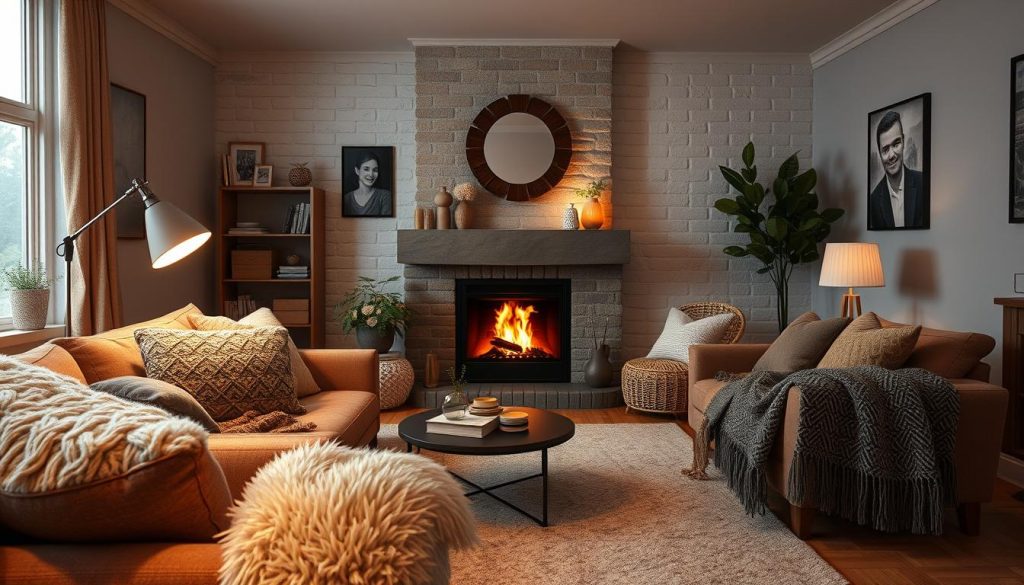
Living Room Sanctuaries
The living room is the heart of your home. It’s where you spend time with loved ones. For a cozy feel, choose plush seating and soft textures like velvet or chenille. Add throw pillows and blankets for warmth.
Use warm lighting, like table lamps or string lights, for a gentle glow. An area rug can define the space and feel soft underfoot.
Bedroom Retreats
Your bedroom should be a peaceful place for sleep. Start with a comfy mattress and soft bedding. Layer your bed with pillows and a cozy duvet.
Choose calming colors like blues, greens, or neutrals. Blackout curtains help block light for better sleep. Adding scents like lavender or vanilla can also help you relax.
Cozy Living Kitchen Designs
The kitchen is for nourishment and gathering. Use warm wood tones and soft lighting to make it cozy. A plush rug in front of the sink adds comfort while cooking.
Display your favorite cookbooks and dishes to invite guests. Adding herbs or plants brings in natural scents and elements.
| Room | Key Cozy Elements |
|---|---|
| Living Room | Plush seating, soft textures, warm lighting, area rug |
| Bedroom | Comfortable bedding, calming colors, blackout curtains, soothing scents |
| Kitchen | Warm wood tones, soft lighting, plush rug, herbs/plants |
| Bathroom | Plush towels, soft rugs, calming scents, warm lighting |
Bathroom Spa Vibes
Make your bathroom a spa with plush towels, soft rugs, and calming scents. Dimmer switches create a warm, relaxing glow. Display your favorite bath products and candles for luxury.
Adding plants purifies the air and brings nature in. Ensure good ventilation for air quality and temperature.
Your home should be the treasure chest of living. – Le Corbusier
The Sensory Approach to Cozy Living
Creating a cozy living space is more than just looks. It’s about using all our senses to make a space that feels warm and inviting. Let’s see how to make your seasonal cozy design sensory.
Furthermore, then adapting your space throughout the year, think about these sensory elements:
- Visual: Warm colors and soft lights make a cozy feel.
- Tactile: Plush fabrics, furry throws, and soft pillows add comfort.
- Olfactory: Scented candles, essential oils, or natural smells like pine or cinnamon create cozy vibes.
- Auditory: Soft music, nature sounds, or a fireplace crackle make a soothing atmosphere.
- Thermal: Keep it comfy with winter warmth strategies or summer comfort solutions like layered bedding or breezy curtains.
“The best rooms have something to say about the people who live in them.” – David Hicks
Here are some ideas for adding sensory elements to your cozy living space for each season:
| Season | Visual | Tactile | Olfactory | Auditory | Thermal |
|---|---|---|---|---|---|
| Winter | Warm lighting, rich colors | Faux fur, knitted blankets | Pine, cinnamon, vanilla | Crackling fireplace | Layered bedding, heated blankets |
| Spring | Pastel hues, floral accents | Lightweight fabrics, linen | Fresh flowers, citrus scents | Chirping birds, light rain | Breezy curtains, open windows |
| Summer | Bright, airy colors | Cotton, bamboo, rattan | Ocean breeze, coconut | Ocean waves, wind chimes | Ceiling fans, sheer fabrics |
| Autumn | Earthy tones, rustic elements | Velvet, corduroy, flannel | Pumpkin spice, apple cider | Rustling leaves, soft jazz | Throw blankets, draft stoppers |
By engaging all our senses, we can make a cozy living space that changes with the seasons. Whether it’s winter warmth strategies or spring refresh ideas, a sensory approach lets us dive into the comfort of home.
Seasonal Cozy: Adapting Your Space Throughout the Year
As the seasons change, our need for coziness grows. By changing your living space to match each season, you can make your home warm and welcoming all year. Let’s look at ways to add seasonal coziness to your home.

Winter Warmth Cozy Living Strategies
During the cold winter months, you can transform your space into a cozy and inviting sanctuary. First, incorporate thick, plush textiles like wool blankets and faux fur throws. Additionally, enhance the atmosphere by incorporating holiday decorations or scented candles to bring forth joy and nostalgia.
Spring Refresh Living Cozy Ideas
As winter fades away, spring brings longer days and warmer weather. Consequently, it’s time to lighten up your space with sheer curtains and natural light. Moreover, introduce floral arrangements and vibrant throw pillows to effectively celebrate the season’s renewal.
Summer Cozy Comfort Solutions
When summer arrives, focus on keeping your space cool and breezy. To achieve this, select lightweight fabrics such as linen and cotton in soft colors. Furthermore, incorporate natural materials like rattan and bamboo to create a coastal feel. In addition, consider including plants or a small water feature to seamlessly bring nature inside.
Autumn Cozy Ambiance Creation
As the leaves begin to change, autumn brings warm, cozy vibes. Therefore, incorporate earthy tones such as terracotta and golden yellow in your decor. Meanwhile, establish a cozy reading nook with plush furniture and soft blankets. Subsequently, introduce comforting scents like cinnamon to enhance the feeling of comfort and nostalgia.
Above all, remember that cozy spaces are fundamentally about emotional safety and belonging. Thus, by thoughtfully changing your home with the seasons, you ultimately create a welcoming space that promotes well-being throughout the year.
| Season | Key Elements | Color Palette |
|---|---|---|
| Winter | Thick textiles, festive decorations, scented candles | Warm whites, rich reds, deep greens |
| Spring | Sheer fabrics, floral arrangements, botanical artwork | Soft pastels, vibrant greens, fresh whites |
| Summer | Lightweight fabrics, natural materials, potted plants | Soft neutrals, cool blues, fresh greens |
| Autumn | Rich textiles, cozy reading nook, seasonal scents | Warm earthy tones, deep reds, golden yellows |
Mindful Elements: The Psychology Behind Cozy Living Spaces
Creating a cozy space is more than just physical elements. It’s about tapping into the psychological aspects that make us feel safe and connected. By adding mindful elements, you can make a space that supports your emotional well-being.
Creating Emotional Safety
Emotional safety is key in a cozy space. Use soft textures, warm colors, and personal items that hold sentimental value. Surrounding yourself with objects that bring positive memories creates comfort and security.
The Role of Nostalgia
Nostalgia is powerful in creating coziness. Adding items from your past, like family heirlooms or childhood mementos, brings back safe and loved times. These elements add personal touches and enhance the cozy feeling.
“Nostalgia is a powerful tool in creating a cozy space. It allows us to tap into our fondest memories and create a sense of comfort and familiarity.” – Sarah Thompson, interior designer
Personal Cozy Space and Boundaries
Cozy spaces respect personal space and boundaries. Create areas for different activities, like reading nooks or meditation corners. Defining these spaces lets you relax and unwind without feeling overwhelmed.
Social Cozy Living Connection Areas
Cozy spaces can also foster social connections. Design inviting seating areas, like a plush sofa, for intimate conversations. These areas add warmth and togetherness to your cozy space.
By adding mindful elements like personal space, nostalgia, and social connection areas to your cozy design, you create a space that feels emotionally nurturing. These aspects, along with natural elements and mindfulness corners, make for the ultimate cozy living experience.
Natural Elements in Cozy Living Design
First and foremost, adding natural elements to your cozy space can significantly improve its feel and comfort. Furthermore, bringing the outdoors inside creates harmony and peace. Therefore, let’s explore various ways to make your home feel more connected to nature.
Indoor Plants and Greenery
Without a doubt, indoor plants are a simple yet powerful way to add nature to your space. As a result, they not only clean the air and increase oxygen but also add vibrant life to any room. Consequently, consider placing a thoughtful mix of plants throughout your home, ranging from small succulents to impressive statement pieces.
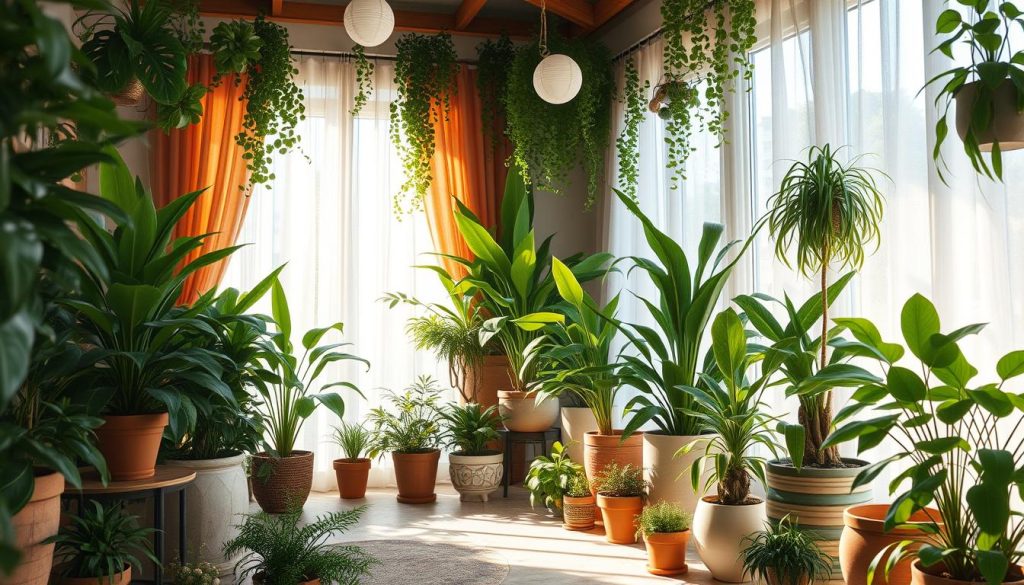
Natural Cozy Materials and Textures
Moreover, using natural materials and textures can effectively make your space feel warmer and more inviting. To achieve this, carefully select wood, stone, bamboo, or rattan for furniture, flooring, and decor. In addition, these organic materials naturally add warmth and authenticity to your home.
Organic Shapes and Forms
In particular, embrace nature’s imperfect beauty by incorporating organic shapes in your design. Specifically, choose furniture and decor with flowing curves and unique shapes. For instance, this can include live-edge tables, hand-thrown vases, or abstract art inspired by nature.
Natural Light Optimization in Cozy Living
Additionally, maximizing natural light is essential to creating a cozy atmosphere. As such, allow sunlight to fill your space through windows or skylights. Meanwhile, if light is scarce, utilize sheer curtains or blinds to soften the light. Furthermore, strategically place mirrors to reflect and enhance the available light.
On top of that, seasonal decorations can also enhance your cozy home. During fall, showcase pumpkins and autumn leaves. Subsequently, winter brings pine cones and evergreen branches. Similarly, spring and summer are perfect for displaying fresh flowers and seashells.
“Nature is not a place to visit. It is home.” – Gary Snyder
In conclusion, by thoughtfully incorporating natural elements, you can transform your space into something truly grounded and peaceful. Ultimately, whether through plants, materials, or seasonal decor, nature can successfully turn any room into a welcoming and cozy haven.
Cozy Living on a Budget
Creating a cozy home doesn’t have to cost a lot. With some creativity and smart choices, you can make your home warm and welcoming without spending too much. Here are some tips to help you achieve cozy living on a budget.
One smart way to save money is by doing DIY cozy projects. You can make your own throw pillows, blankets, or even a coffee table. These projects add a personal touch and keep your budget in check.
Thrifting for cozy elements is another great way to save. Look for unique and affordable decor at thrift stores, yard sales, or online. You can find vintage frames, cozy throws, or even a statement piece of furniture.
Also, think about repurposing existing items in your home. Look at what you already have and see how you can make it cozy. For example, you can paint an old bookshelf, reupholster a chair, or turn a vintage ladder into a blanket rack.
“The best way to find out what we really need is to get rid of what we don’t.” – Marie Kondo
Lastly, use seasonal budget updates to keep your space fresh. Change out throw pillows, blankets, and decor to match the seasons without spending a lot.
| Budget-Friendly Cozy Ideas | Estimated Cost |
|---|---|
| DIY Throw Pillows | $10-$20 |
| Thrifted Vintage Frames | $5-$15 |
| Repurposed Ladder Blanket Rack | $0-$10 |
| Seasonal Throw Blanket | $15-$30 |
By using these budget-friendly ideas, you can create a cozy home that shows your style without breaking the bank.
Personalizing Your Cozy Living Space: Making It Uniquely Yours
To make your living space cozy, personalizing your cozy space is essential. Adding personal collections and creating memory corners turns your home into a warm, inviting place. It shows off your unique style and personality.
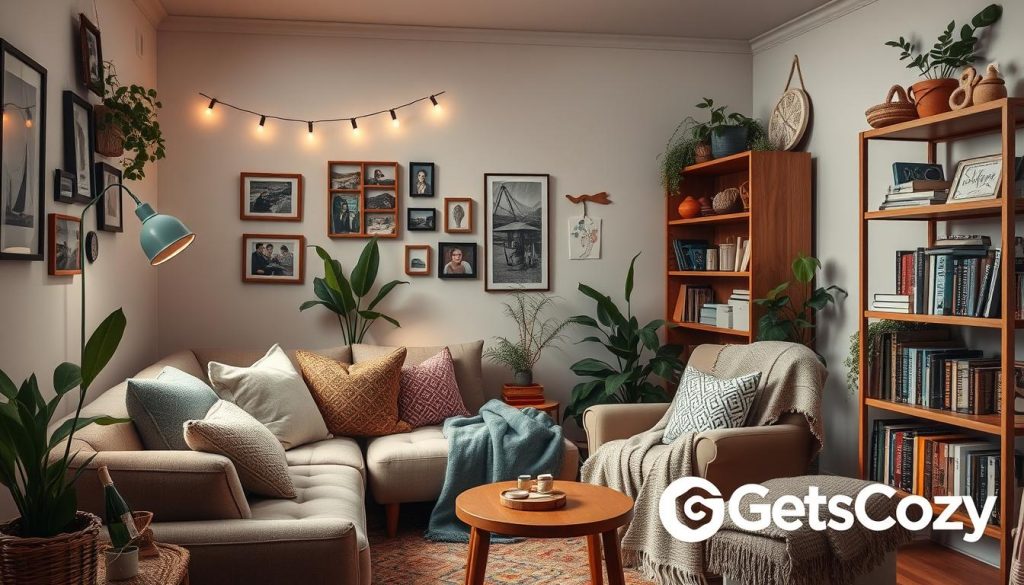
Displaying special items makes your space feel like home. It could be vintage books, family heirlooms, or travel souvenirs. These personal touches add character and charm to any room.
Creating Memory Cozy Corners
To personalize your space, create memory corners. These areas have photos, artwork, and mementos that bring back good memories. Try setting up a gallery wall or a cozy reading nook with your favorite books.
Family-Friendly Cozy Living Spaces
Creating cozy spaces for kids and pets is important. Here are some tips for making these areas welcoming:
- Choose durable, easy-to-clean fabrics for furniture and throw pillows
- Incorporate soft, plush rugs for playing and lounging
- Set up a cozy reading corner with floor cushions and bean bags
- Use pet beds and blankets that match your decor
Investment Cozy Pieces Worth Splurging On
While you don’t have to spend a lot, some investment pieces worth splurging on enhance coziness. Consider these:
| Room | Investment Piece | Cozy Factor |
|---|---|---|
| Living Room | High-quality sofa | Plush, supportive cushions for ultimate lounging |
| Bedroom | Luxury mattress | Restful sleep and rejuvenation |
| Home Office | Ergonomic desk chair | Proper support for long work sessions |
By adding personal touches, memory corners, and family-friendly elements, you create a cozy haven. It’s a place you’ll never want to leave. Embrace your individuality and let your space tell your story. That’s the essence of true coziness.
DIY Cozy Living Projects
Creating a cozy living space doesn’t have to be expensive. With a bit of creativity and DIY projects, you can make your home warm and welcoming. You can make family-friendly cozy spaces or pet-friendly cozy solutions without spending a lot. There are many ways to adapt your design to your lifestyle on a budget.
Thrifting for Cozy Living Elements
Thrifting is a great way to find unique, affordable pieces for your cozy home. Look for items like chunky knit blankets, vintage artwork, and plush pillows. These add texture and personality to your space. Mixing styles can create a laid-back, eclectic vibe.
“The best rooms have something to say about the people who live in them.” – David Hicks
Repurposing Existing Items
Before buying new decor, look around your home for items to repurpose. An old ladder can become a blanket rack, and mason jars can hold candles or flowers. Think creatively to give new life to everyday objects.
Seasonal Budget Cozy Living Updates
Decor changes with the seasons. Instead of redoing your whole space, make small, affordable updates. Add cozy throw blankets and scented candles in fall. In spring, introduce fresh greenery and light curtains. These changes can greatly enhance your space without costing a lot.
Investment Pieces Worth Splurging On
While DIY and thrifted items are great, some pieces are worth spending more on. A comfy sofa, quality bedding, and durable rugs are investments that last. Choose items that are functional and fit well in your space, avoiding clutter.
The Difference Between Cozy and Cluttered
Creating a cozy living space means finding the right balance. It’s about comfort without clutter. The key is in visual elements and composition. Arrange your belongings to create warmth and relaxation, avoiding an overcrowded room.
In addition to keep your space cozy without clutter, focus on tactile experiences and textures. Use soft fabrics like chunky knit throws and fluffy rugs. These add depth and comfort without clutter.
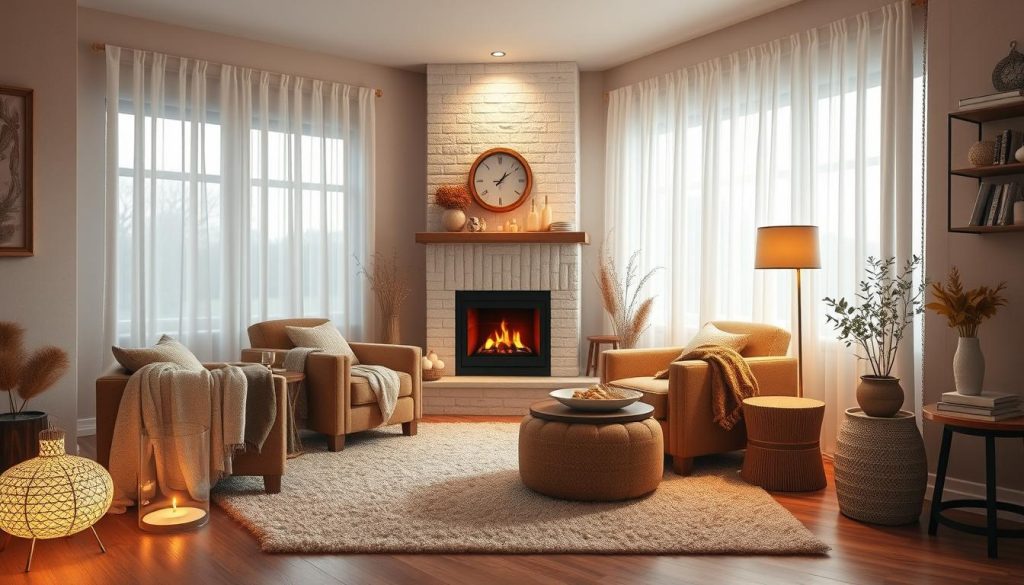
Aromatherapy and scent design also play a role. Pleasant fragrances from candles or flowers can make a room cozy. But, too many scents can be overwhelming.
“The art of creating a cozy space is about editing – keeping only what truly matters and brings you joy.” – Marie Kondo
Acoustic comfort is crucial for coziness. Soft furnishings can absorb noise, making a room intimate. But, too much can make it feel stuffy. Find the right balance.
Lastly, consider temperature and air quality. A cozy space should be warm but not hot. Use layered bedding and ensure good ventilation. A cluttered room can trap heat, making it feel oppressive.
| Cozy | Cluttered |
|---|---|
| Thoughtfully curated items | Too many unnecessary objects |
| Soft, inviting textures | Overwhelming patterns and colors |
| Subtle, pleasant scents | Competing or overpowering fragrances |
| Balanced acoustic comfort | Stuffy, noise-trapping environment |
| Comfortable temperature and air quality | Stifling heat or poor ventilation |
By focusing on balance and intention in decor, you can create a cozy space. It should feel welcoming and serene, not cluttered or chaotic.
Visual Elements and Composition in Cozy Living Spaces
Creating your perfect cozy haven involves more than just furniture. The visual elements and how you arrange them are key. By choosing and placing different components carefully, you can make your space warm and inviting. It will engage all your senses.
Tactile Experiences and Textures for Cozy looks
Adding various textures is crucial for a cozy atmosphere. These textures should invite touch and feel comforting. Here are some textural elements to enhance your space’s coziness:
| Textural Element | Examples | Benefits |
|---|---|---|
| Soft fabrics | Plush throw pillows, cozy blankets, fluffy rugs | Provides a sense of warmth and comfort |
| Natural materials | Wood, stone, woven baskets | Adds organic beauty and grounding energy |
| Textured walls | Woven wallpaper, embossed panels | Creates visual interest and depth |
Aromatherapy and Cozy Scent Design
Smell plays a big role in making a space cozy. Certain scents can make you feel warm, relaxed, and comfortable. Here are some ways to add cozy scents to your living space:
- Scented candles with soothing fragrances like vanilla, lavender, or cinnamon
- Essential oil diffusers to disperse calming scents throughout the room
- Naturally fragrant plants such as jasmine or eucalyptus
Acoustic Comfort
Acoustic comfort is vital for a cozy atmosphere. Soft surfaces and sound-absorbing materials can reduce noise and create peace. Here are some tips for better acoustics:
- Incorporating plush rugs or carpets to absorb sound
- Hanging curtains or tapestries to dampen echoes
- Using upholstered furniture to soften the acoustic environment
Temperature and Air Quality
The temperature and air quality of your space greatly affect coziness. To make your space comfortable and inviting, consider these tips:
- Maintain a comfortable temperature, neither too hot nor too cold
- Use fans or open windows to promote air circulation and freshness
- Invest in an air purifier to remove allergens and improve air quality
- Incorporate humidity control measures for optimal comfort
By focusing on visual elements, textures, scents, acoustics, and air quality, you can create a cozy haven. This haven will nurture your well-being and offer a peaceful retreat. With these 100 cozy living ideas, you can turn your space into a warm and welcoming retreat.
Conclusion
Creating a cozy living space is about feeling comfortable and relaxed. This guide shared 100 ideas to inspire your cozy style. You now know how to make your home warm and inviting.
Cozy living is personal. It’s about finding what makes you happy. Therefore try different colors, textures, and decor to find your perfect mix.
Cozy living is a journey, not a goal. Your space should change with you. Keep finding inspiration from nature, travel, and people. This way, your home will always feel like a warm hug.

